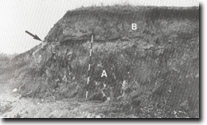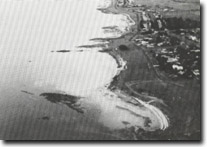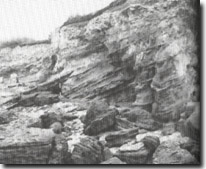19 Steeles Rock, Portarlington - Geological Section
|
This information has been developed from one or more of these publications:
|
| Location | 951791 to 955781. Approximately 400 m of coastline including cliffs and shore platforms between Simpson Street and Gellibrand Street, Portarlington. The site includes the reefs and low rocks known as Steeles Rock. |  Site 19, Unconformity (arrowed) between Older Volcanic basalt (A) and Moorabool Viaduct Formation (B), Portarlington |
Access | The Esplanade, Portarlington. | |
Ownership/Managing Authority | Crown land (Portarlington Foreshore Committee of Management and Department of Conservation, Forests and Lands). | |
Site Description | Continuous outcrop along a 200 m section of coastal cliff displays a variety of volcanic and sedimentary materials. The cliffed section, reaching 4 m high, extends from just west of the white beacon westward to near the toilet block, where the cliff swings inland to be a low bluff which turns coastward as a rocky promontory. Weathered basalt outcrops in the west of the section (from the promontory to beyond the toilet block) and is overlain with marked angular unconformity by ferruginous and calcareous and gravely sediments. The basal beds of the sediments are coarse sand and small gravels, passing upward into ferruginous cross-bedded sands and grits. Towards the east, the beds have a pronounced dip eastward of about 30o opposite the white beacon. The upper metre of the section is a fossiliferous calcareous bed which in places has been further cemented by secondary calcite deposition. The fossils are all of living species of bivalves or gastropods. | |
The structure and stratigraphical relationship of the beds has been the subject of much discussion. They have been correlated with either the Moorabool Viaduct Sand (Upper Pliocene) or regraded as younger Pleistocene beds. At the western edge of the site, the geology is also complex with indurated dipping sandstones forming rugged low headlands and shore platforms. Some of the outcrop on the western platform may be of Cretaceous sandstone which occurs inland but is not mapped as coastal exposures. | ||
 Site 19, Steeles Rocks, Portarlington |  Site 19, Dipping ferruginous beds overlain by calcareous beds, Steeles Rock section, Portarlington |



